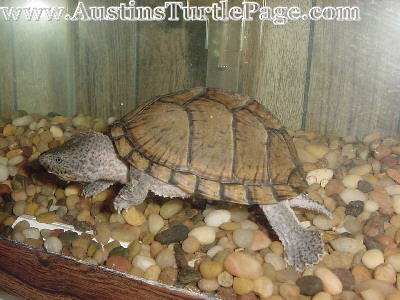SCIENTIFIC NAME
Sternotherus carinatus
ADULT SIZE
Up to 5 - 6"
DIET
In the wild, they are carnivores, feeding upon mollusks, snails, aquatic insects, crawdads or any other animal matter they can find.
TEMPERATURE RANGE (°F)
Air Temperature: 75° - 83°
Basking Temperature: Mid 80's to low 90's
Water Temperature: Mid to High 70's
HABITAT
Inhabits slow moving rivers, swamps and oxbows of large rivers.
DISTRIBUTION
Found in Louisiana, Mississippi, Arkansas, east Texas, and SE Oklahoma.
BEGINNER TURTLE
Yes
CAPTIVE HABITAT
Being more aquatic than the closely related mud turtles, razorback musk prefer a greater sized water area. Razorback musk are well able to thrive in deep water habitat. Though infrequent baskers, ample opportunity to do so is important. A spotlight over their basking area will be utilized. This area can be in the form of a rock projecting from the water, or in the case of young specimens, floating aquatic plants are preferred. Razorbacks are more shy by nature than other species of musk turtles, and a substrate of river pebbles seems to give them a greater sense of security.
RECOMMENDED ENCLOSURE
A thirty gallon aquaria is sufficient for razorbacks. The addition of more than a single specimen would require the keeper to adjust the enclosure size accordingly. As always, when possible, more room is always better. These are active turtles, and they will utilize the space offered. Strong filtration is advised, as these are messy feeders, and water quality is often compromised if filtration is not adequate. The addition of rocks and aquatic plants are advised owing to this species shy nature, and the greater sense of security that these provide. This especially true of young specimens. Given the southern distribution of this species, they are less likely to be as cold tolerant as the stinkpot.
CAPTIVE DIET
In captivity, Does well on high quality turtle pellets such as Mazuri and Reptomin, as well as earth worms, crawdads and feeder fish on occasion.
COMMUNITY HABITAT
Given ample space, razorbacks do very well in community settings. Painted turtles, sliders, and cooters are good choices as tank mates. Razorbacks are well able to live in the deeper water that these basking species require, and usually coexist peacefully provided the size difference of the inhabitants is not pronounced. Caution is advised when maintaining any musk turtles together with their own kind or closely related species. Aggression between rival males, or with unreceptive females often results. As with mud turtles, these situations should be monitored closely. Razorback's are the largest of the musk turtles.
OTHER INFORMATION
Perhaps the shyest of the musk turtles. Not inclined to bite. Like all musk turtles, they are infrequent baskers.
from: By Phil -www.austinsturtlepage.com
Sternotherus carinatus
ADULT SIZE
Up to 5 - 6"
DIET
In the wild, they are carnivores, feeding upon mollusks, snails, aquatic insects, crawdads or any other animal matter they can find.
TEMPERATURE RANGE (°F)
Air Temperature: 75° - 83°
Basking Temperature: Mid 80's to low 90's
Water Temperature: Mid to High 70's
HABITAT
Inhabits slow moving rivers, swamps and oxbows of large rivers.
DISTRIBUTION
Found in Louisiana, Mississippi, Arkansas, east Texas, and SE Oklahoma.
BEGINNER TURTLE
Yes
CAPTIVE HABITAT
Being more aquatic than the closely related mud turtles, razorback musk prefer a greater sized water area. Razorback musk are well able to thrive in deep water habitat. Though infrequent baskers, ample opportunity to do so is important. A spotlight over their basking area will be utilized. This area can be in the form of a rock projecting from the water, or in the case of young specimens, floating aquatic plants are preferred. Razorbacks are more shy by nature than other species of musk turtles, and a substrate of river pebbles seems to give them a greater sense of security.
RECOMMENDED ENCLOSURE
A thirty gallon aquaria is sufficient for razorbacks. The addition of more than a single specimen would require the keeper to adjust the enclosure size accordingly. As always, when possible, more room is always better. These are active turtles, and they will utilize the space offered. Strong filtration is advised, as these are messy feeders, and water quality is often compromised if filtration is not adequate. The addition of rocks and aquatic plants are advised owing to this species shy nature, and the greater sense of security that these provide. This especially true of young specimens. Given the southern distribution of this species, they are less likely to be as cold tolerant as the stinkpot.
CAPTIVE DIET
In captivity, Does well on high quality turtle pellets such as Mazuri and Reptomin, as well as earth worms, crawdads and feeder fish on occasion.
COMMUNITY HABITAT
Given ample space, razorbacks do very well in community settings. Painted turtles, sliders, and cooters are good choices as tank mates. Razorbacks are well able to live in the deeper water that these basking species require, and usually coexist peacefully provided the size difference of the inhabitants is not pronounced. Caution is advised when maintaining any musk turtles together with their own kind or closely related species. Aggression between rival males, or with unreceptive females often results. As with mud turtles, these situations should be monitored closely. Razorback's are the largest of the musk turtles.
OTHER INFORMATION
Perhaps the shyest of the musk turtles. Not inclined to bite. Like all musk turtles, they are infrequent baskers.
from: By Phil -www.austinsturtlepage.com


0 comments:
Post a Comment